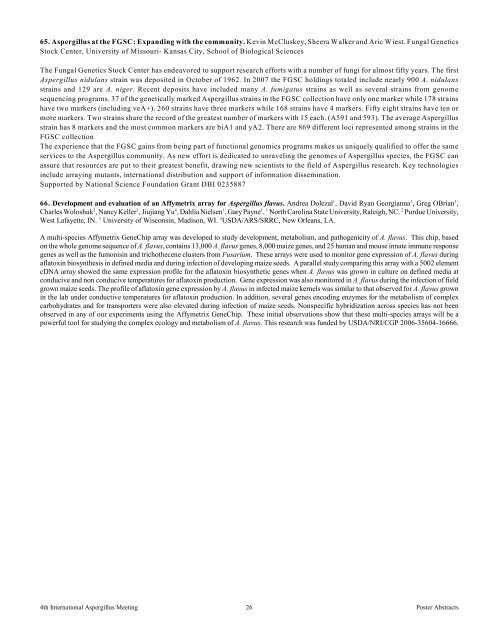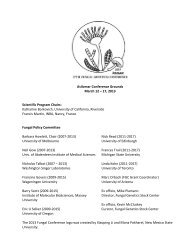Asperfest 4 Program - Fungal Genetics Stock Center
Asperfest 4 Program - Fungal Genetics Stock Center
Asperfest 4 Program - Fungal Genetics Stock Center
Create successful ePaper yourself
Turn your PDF publications into a flip-book with our unique Google optimized e-Paper software.
65. Aspergillus at the FGSC: Expanding with the community. Kevin McCluskey, Sheera Walker and Aric Wiest. <strong>Fungal</strong> <strong>Genetics</strong><br />
<strong>Stock</strong> <strong>Center</strong>, University of Missouri- Kansas City, School of Biological Sciences<br />
The <strong>Fungal</strong> <strong>Genetics</strong> <strong>Stock</strong> <strong>Center</strong> has endeavored to support research efforts with a number of fungi for almost fifty years. The first<br />
Aspergillus nidulans strain was deposited in October of 1962. In 2007 the FGSC holdings totaled include nearly 900 A. nidulans<br />
strains and 129 are A. niger. Recent deposits have included many A. fumigatus strains as well as several strains from genome<br />
sequencing programs. 37 of the genetically marked Aspergillus strains in the FGSC collection have only one marker while 178 strains<br />
have two markers (including veA+). 260 strains have three markers while 168 strains have 4 markers. Fifty eight strains have ten or<br />
more markers. Two strains share the record of the greatest number of markers with 15 each. (A591 and 593). The average Aspergillus<br />
strain has 8 markers and the most common markers are biA1 and yA2. There are 869 different loci represented among strains in the<br />
FGSC collection<br />
The experience that the FGSC gains from being part of functional genomics programs makes us uniquely qualified to offer the same<br />
services to the Aspergillus community. As new effort is dedicated to unraveling the genomes of Aspergillus species, the FGSC can<br />
assure that resources are put to their greatest benefit, drawing new scientists to the field of Aspergillus research. Key technologies<br />
include arraying mutants, international distribution and support of information dissemination.<br />
Supported by National Science Foundation Grant DBI 0235887<br />
1 1 1<br />
66. Development and evaluation of an Affymetrix array for Aspergillus flavus. Andrea Dolezal , David Ryan Georgianna , Greg OBrian ,<br />
2 3 4 1 1 1 2<br />
Charles Woloshuk , Nancy Keller , Jiujiang Yu , Dahlia Nielsen , Gary Payne . North Carolina State University, Raleigh, NC. Purdue University,<br />
3 4<br />
West Lafayette, IN. University of Wisconsin, Madison, WI. USDA/ARS/SRRC, New Orleans, LA.<br />
A multi-species Affymetrix GeneChip array was developed to study development, metabolism, and pathogenicity of A. flavus. This chip, based<br />
on the whole genome sequence of A. flavus, contains 13,000 A. flavus genes, 8,000 maize genes, and 25 human and mouse innate immune response<br />
genes as well as the fumonisin and trichothecene clusters from Fusarium. These arrays were used to monitor gene expression of A. flavus during<br />
aflatoxin biosynthesis in defined media and during infection of developing maize seeds. A parallel study comparing this array with a 5002 element<br />
cDNA array showed the same expression profile for the aflatoxin biosynthetic genes when A. flavus was grown in culture on defined media at<br />
conducive and non conducive temperatures for aflatoxin production. Gene expression was also monitored in A. flavus during the infection of field<br />
grown maize seeds. The profile of aflatoxin gene expression by A. flavus in infected maize kernels was similar to that observed for A. flavus grown<br />
in the lab under conductive temperatures for aflatoxin production. In addition, several genes encoding enzymes for the metabolism of complex<br />
carbohydrates and for transporters were also elevated during infection of maize seeds. Nonspecific hybridization across species has not been<br />
observed in any of our experiments using the Affymetrix GeneChip. These initial observations show that these multi-species arrays will be a<br />
powerful tool for studying the complex ecology and metabolism of A. flavus. This research was funded by USDA/NRI/CGP 2006-35604-16666.<br />
4th International Aspergillus Meeting 26 Poster Abstracts











